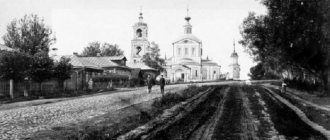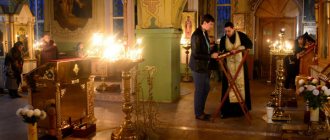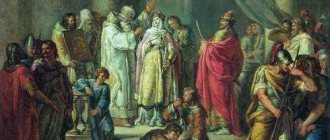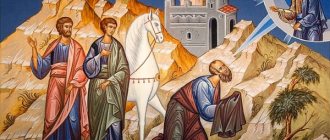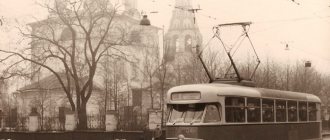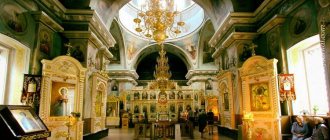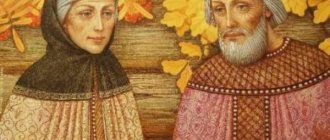Canonical image
The Holy Apostle Peter is depicted in the icon as a wise old man with a short beard, sometimes with curly hair. His outer clothes are always golden in color, his under clothes are dark blue or blue-green. With his right hand he blesses or holds the keys of the Kingdom of Heaven. In his left hand he holds a scroll with the text or gospel words: “You are the Christ, the son of the living God” (Matthew 16: 16).
The Holy Apostle Paul on the icon is depicted with a high forehead, slightly bald, with dark hair, and a wide beard. He usually holds a scroll, sometimes as a single book or as 14 rolls tied together. His outer clothing is brown or dark purple, and his chiton is light, blue or blue-green.
Iconography
The icon of the holy apostles Peter and Paul can essentially be called the iconography of their holiday. The tradition of depicting them together comes from the time of its establishment.
Apostles Peter and Paul School or art. center: Central Rus' Beginning of the 16th century. Russian icon 1988: XVI century. State Historical Museum 2006: Beginning of the 16th century. Wood, gesso, tempera. 142 × 91 cm State Historical Museum, Moscow, Russia Inv. 58384 AND VIII 5287
The very first artifacts, with stylized figures of Christ and the supreme apostles, belong to cult objects and date back to the second, third or fourth centuries. The Apostles Peter and Paul were depicted on the bottoms of funeral vessels, which may have also served for the Eucharist.
On the bottom from the Metropolitan Museum in the USA, there is a drawing of a laurel crown, as if floating above the figures of the apostles. The crown is a symbol of their martyrdom, glorification by the Lord and triumph, victory over death. The etymology of triumph comes from Hellenic art, in which there was a very strong tradition of depicting victorious warriors on all kinds of ceramics.
Useful materials
A bas-relief on a stone, repeating the iconography of interest to us, is located in the National Archaeological Museum of Aquileia, Italy, dating back to the fifth century. This is one of the possible prototypes of the iconographic version of “The Embrace of the Holy Apostles Peter and Paul.”
The unification of the apostles in one iconographic image became a natural development of the established liturgical practice. The fresco icon images that follow are directly related to the hagiographic legend about the death of the apostles on one day. There is a story that the apostles saw each other before their death.
Church tradition has preserved an accurate description of the appearance of the holy apostles. Their earliest images, repeatedly reproduced on frescoes, reliefs and funeral utensils of early Christianity, gradually migrated into icon paintings. Along with the appearance of the iconostasis - the altar barrier, the iconography of saints also developed.
The first icon of St. Peter the Apostle that has come down to us, painted on a board using the encaustic technique (painting with wax paints), has the same characteristic features as his earlier fresco images. The ancient image dates back to the sixth century and is kept in the monastery of St. Catherine on the island of Sinai.
Apostle Peter VI century. Frühe Ikonen 1972: 7th century. Essays on the history of art 1987: VI century. Βοκοτοπουλος 1995: Second half of the 6th - beginning of the 7th centuries. Bayet 2009: VI century. To the origins 2009: VI century. Encaustic icon 92.8 × 53.1 cm Monastery of St. Catherine, Sinai, Egypt
The Apostle is depicted as a mature man, with thick gray hair, large kind eyes and a very characteristic forehead line. The Sinai icon depicts the Apostle Peter, with keys in his hands, as if illustrating the words of the Lord:
“...blessed are you, Simon... and I say to you: you are Peter, and on this rock I will build My Church, and the gates of hell will not prevail against it; and I will give you the keys of the kingdom of heaven: and whatever you bind on earth will be bound in heaven, and whatever you loose on earth will be loosed in heaven.”
In the hands of St. Peter, the staff is an attribute of pastoral dignity, and its cruciform shape is interpreted as a symbol of martyrdom. The Sinai icon is a kind of prototype of subsequent canonical images of St. Apostle Peter.
The image of the Apostle Paul also has individual features. The art of Roman portraiture contributed to the emergence of the iconographic face of the saint. His most famous Russian icon of the fifteenth century is part of the Deesis from the iconostasis of the famous Zvenigorod rank of St. Andrei Rublev, partly reproduces the Byzantine iconography of the apostle that had already developed by this period.
Apostle Paul From the Deesis rite Rublev Andrey School or art. center: Moscow 1410s Exhibition 1960: Before 1407 (?) Antonova, Mneva 1963: 1420s Lazarev 1966/1: Approx. 1410–1415 Alpatov 1972: Beginning of the 15th century. Onasch 1977: Ok. 1407 Lazarev 2000/1: 1410s Popov 2007/1: Ok. 1400 Sarabyanov, Smirnova 2007: Beginning of the 15th century. 160 × 110 cm State Tretyakov Gallery, Moscow, Russia Inv. 12865
It is interesting that the personal letter of the “Rublevsky” Paul, artistically, is very close to the image of the sixth century, located in the Basilica of San Vitale, in the Italian Ravenna.
The iconic attribute of the Holy Apostle Paul is considered to be a sword, the instrument of his execution and a sign of martyrdom. Gradually, with the development of the image, a tradition developed to depict the Apostle Paul in a blue tunic and a red cloak, which could also be cherry or a muted cinnabar shade. Peter's vestments are traditionally golden or ocher, his chiton is blue.
Naturally, over time, all the symbolism of the individual images also transferred into the paired image. The Russian Novgorod icon of the ninth century is an excellent example of Byzantine syncretism. The paired “deesis” icon of the apostles was traditionally part of the iconostasis - “deisis” (or prayer), a very common iconography that gave rise to individual versions.
Apostles Peter and Paul Late XIV - early XV centuries. Icons of the Assumption Cathedral 2007: The end of the XIV - first quarter of the XV centuries. 196 × 138 cm Assumption Cathedral of the Moscow Kremlin, Moscow, Russia Inv. 1078 personalities; Zh-270
The theological content of the image, known as the “Embrace of the Apostles,” is full of deep evangelical meaning. The icon symbolizes the superiority of divine love over the secular fallen nature of man; in God, in Christ, nothing can divide people. There is no origin - “neither Greek nor Jew”, social status is leveled, nation or education does not matter. This is a gospel image about the priority of love.
How does the icon of Peter and Paul help?
In front of the apostles Peter and Paul on the icon they pray mostly for matters related to faith, because they were active disseminators and preachers of Christianity. Even now they can help ordinary people strengthen their faith and become more righteous. The prayer can be performed to each saint separately or to two at once; if you turn to one person, there is nothing terrible in this; it is even possible to more competently differentiate prayers depending on the goal.
If the emphasis is on the image of Peter in the icon and prayer to this apostle, then he is often approached with requests to be confirmed in the faith, and also fishermen who are assisted by the saint turn to him. In turn, Saint Paul on the icon serves as an image to which people turn in order to receive blessings and help in their studies. After all, Pavel was a deeply educated person and is secretly considered an assistant in various matters related to study and education.
As such, the icon of Peter and Paul is considered miraculous and can grant healing. Sincere faith can do miracles, which is why you should not limit yourself too strictly. It is permissible to ask an icon for almost anything within the framework of the Orthodox faith.
Key and sword
About the Holy Apostles Peter and Paul
Thank God there is salvation.
Among lost people.
In repentance with correction
Spend the rest of your days.
Prot. Valerian Krechetov
Already in the 1st century, a celebration was established in the Church in honor of the holy supreme apostles Peter and Paul, which became widespread from the 4th century. The names of the apostles Peter and Paul forever merged together.
Apostle Peter
The Holy Chief Apostle Peter, a native of the city of Bethsaida, the brother of the Holy Apostle Andrew the First-Called, a disciple of John the Baptist, lived with his family in Capernaum and was engaged in fishing. His name was Simon, and he received the name Peter (stone) from Jesus Christ Himself.
The Apostle Peter was the first to believe in the Divine message of the Lord; together with the apostles James and John, Peter witnessed the resurrection of Jairus’s daughter, and saw the glory of the Lord on Mount Tabor during the Transfiguration. He remained with Christ in the Garden of Gethsemane on the eve of his betrayal by Judas.
And at the same time, Peter did not escape the terrible sin of apostasy, which subsequently redeemed his whole life.
After the arrest of Christ, Peter, out of cowardice, renounced his Teacher three times with an oath. But Peter’s subsequent sincere repentance was accepted by the Lord.
After this, Christ again confirmed Peter in the apostolic title, repeating three times: “Feed My sheep.”
And Peter became one of the boldest preachers of the Gospel.
Already on the day of Pentecost, he converted first 5,000 and then another 3,000 people to the faith of Christ.
Although the Apostle Peter preached mainly among Jews, it was he who was the first to baptize a former pagan - the Roman centurion Cornelius and his family. This event was preceded by a vision of a canvas descending from heaven, filled with various animals and reptiles, which the Jews considered unclean by law and did not eat them as food. The voice commanded Peter to “slaughter and eat” and not to consider unclean what God had cleansed. This vision marked the conversion of the pagans to Christ.
After the Ascension of Christ into heaven, the apostle preached the Gospel in Samaria, Judea and Syria. He founded the Church in Antioch and was its first bishop, and in recent years he preached and led the Christian community in Rome.
The Apostle Peter became famous for his many healings, and in Joppa he raised Tabitha from the dead. He testified about Christ before the Jewish leaders and the court of the Sanhedrin, was twice imprisoned, doomed to death, but was freed by an angel.
Peter visited various countries of the East and West and finally died as a martyr in Rome around 67. Sentenced to the cross, he asked to be crucified upside down, considering himself unworthy to die like the Lord.
Two of his Epistles remain from the Apostle Peter.
In the First Epistle, he commands Christians to endure all sorrows and persecutions with the hope of eternal life. The Apostle reveals the duties of the priests in relation to the flock, of the people - in relation to their shepherds. He speaks about the high moral purity of the Christian family, especially about the role of women in it, convincing Christian women not to imitate the pagans in the pursuit of luxury. The Apostle Peter condemns this false beauty, which deceives some, causes envy in others, and most importantly, fills a person’s heart with pride. He convinces that a woman should be adorned with meekness and beauty of spirit. The Apostle calls not to repay evil for evil, curse for curse, calls to respond to a curse with a blessing, because Christians have the promise of a blessed Kingdom of Heaven.
In the Second Epistle, the Apostle Peter writes about the future of the Church and the world. He warns that in the last days there will be an increase in false teachers who will deceive Christians with empty and false speech. These false teachers will be crafty, lovers of money, will indulge human passions and lusts in order to attract people to themselves, will be proud, self-willed and slanderous. Christians, the apostle reminds, expect nothing else but the transformation of the world: a new Earth and a new heaven.
Apostle Paul
The holy supreme apostle Paul, before accepting Christianity, bore the name Saul, which means “begged”, “begged for”.
He was from Tarsus, whose inhabitants enjoyed the rights of Roman citizens. He was brought up under the famous Jewish teacher of the law Gamaliel. Saul grew up as an active defender of Russian law and fatherly traditions. The gospel preaching of the apostles aroused his indignation, and he became one of their main persecutors. He even went to Damascus, where many of Christ’s disciples hid from the Jews, in order to deliver them to Jerusalem.
During the journey, a miracle happened to him. An extraordinary Light, brighter than the sun, pierced those on the way. The soldiers fell to the ground, and the shocked Saul heard: “Saul! Saul! Why are you persecuting Me? It’s hard for you to go against the grain.”
“Who are you, Lord?” asked Saul, trembling with horror. “I am Jesus, whom you persecute,” was the answer. “But get up and stand on your feet; For this is why I came to you, to make you a minister and a witness of what you have seen and what I will reveal to you” (Acts 26:14-16).
After seeing the Divine Light, Saul became blind. Shocked, he was brought to Damascus. There Saul did not eat for three days, remaining in prayer. At this time, the Apostle Ananias, who lived in Damascus, was commanded by the Lord to heal Saul, whom the Lord called His “chosen vessel,” and the apostle fulfilled God’s will - he found the blind man in Damascus and laid his hands on him.
Saul received his sight—physically and spiritually. The Apostle Ananias baptized him. From now on, God's chosen one began to be called Paul.
From that time on, Paul became a new man.
The Apostle Paul performed many miracles, founded many churches, gave many speeches, wrote letters, 14 of which have reached us.
The Apostle Paul himself says about himself: “...I, circumcised on the eighth day, from the family of Israel, the tribe of Benjamin, a Jew of the Hebrews, according to the teaching of a Pharisee, through zeal a persecutor of the Church of God, and according to legal righteousness blameless. But what was an advantage for me, I counted as loss for the sake of Christ. And I count all things as loss for the sake of the excellence of the knowledge of Christ Jesus my Lord: for Him I have suffered the loss of all things, and count them as rubbish, that I might gain Christ... I say this not because I have already attained or been perfected; But I press on lest I may attain as Christ Jesus attained to me” (Phil 3:5-8, 12).
In another Epistle, he writes that he despised everything worldly and wants to know only one Christ, and Him crucified (see: 1 Cor 2.2).
Paul did not see the Savior in the flesh, but after he was baptized, he retired to the Arabian desert for three years, and there the Lord Himself appeared to him and taught the Gospel, as before - His disciples. That is why the Apostle Paul says that he was taught not by men, but by God Himself.
Nothing could separate Saint Paul from the love of God in Jesus Christ.
“If I speak in the tongues of men and of angels, but do not have love, then I am a ringing gossamer or a clanging cymbal. If I have the gift of prophecy, and know all mysteries, and have all knowledge and all faith, so that I could move mountains, but do not have love, then I am nothing. And if I give away all my property and give my body to be burned, but do not have love, it does me no good. Love is patient, merciful, love does not envy, love is not arrogant, is not proud, is not rude, does not seek its own, is not irritated, does not think evil, does not rejoice in unrighteousness, but rejoices with the truth; covers all things, believes all things, hopes all things, endures all things. Love never fails, although prophecy will cease, and tongues will be silent, and knowledge will be abolished” (1 Cor 13:1-8).
He worked harder than all the apostles, preaching in the territory from Arabia to Spain, forming the Churches of Christ everywhere. It was in Antioch that believers in the Savior began to be called Christians.
The Apostle Paul also did not escape the cup of martyrdom. He was executed in 67 at the same time as the Apostle Peter, but as a Roman citizen he was not crucified, but beheaded. His relics, like those of the Apostle Peter, were buried in Rome.
Key and sword
Both Apostles have the same glory, the same greatness, the same talents, the same spiritual insight, they stand side by side at the throne of God.
On some icons, the Apostle Peter is depicted with keys in his hands, and the Apostle Paul with a drawn sword.
Keys are a sign of the power to forgive and resolve sins, that is, symbolically, to open the doors to the Kingdom of Heaven.
The keys in the hand of the Apostle Peter are, first of all, a symbol of absolution, the right to which the Lord gave to his disciples, and through them to all priests.
The Apostle Paul is depicted with a naked sword in his hands. The sword is the Word of God (see: Eph 6.17), penetrating to the very depths of the human heart. This is the sermon of the apostles, the Gospel teaching is the mirror of our soul and life. The sword is a warrior's weapon. With his word, the Apostle Paul won the souls of sinful people from the dark spirits and turned them to Christ.
Gift as a benefit for everyone
God gives ministry and gifts to everyone: those whom God “predestined, he also called; and those whom he called, he also justified; and those whom he justified, he also glorified” (Rom 8:30). And “the manifestation of the Spirit is given to everyone for the benefit” (1 Cor 12:7). The election of God made Paul an apostle, and his ministry, like the ministry of the Apostle Peter, belongs to the entire Church.
On the confession of the Apostle Peter (the first among the confessions of all the faithful) the Church is built, because he was chosen to testify that the only foundation of this Church is Christ, the Son of the Living God.
Understand and accept others
The apostles Peter and Paul met at the Council of Jerusalem in 51. This was the first council of the Church, on the agenda of which was the first difficult question of church life: should Christians converted from paganism observe the Jewish Law?
Peter stood up for severity, Paul for reasonable leniency towards people of a different culture. The solution to this problem became a compromise: the former pagans were not burdened with fulfilling the Old Testament norms, with the exception of the prohibition on fornication and eating food sacrificed to idols and blood.
The apostles Peter and Paul were very different people, but they entered the history of the Church together. Both apostles dedicated their lives to Jesus. In addition to differences in views, they had a common love - Christ. Following Him, they could find a common language with each other and act for the good of the Church, not tearing it apart with contradictions, but holding it together with wise decisions. Each of them, adhering to their own beliefs, could hear and hear the other.
All people are different. This is our weakness, but this is also our strength. If we argue pointlessly and prove that we are right, everyone will be left alone with their truth. If we learn to hear each other and find a common language, then together we can improve and change the world for the better. And the holy supreme apostles Peter and Paul serve as an example to us that this is possible.
Each of us is connected with the apostles, connected by life and calling, both with the Apostle Peter and with the Apostle Paul.
We are connected with the Apostle Peter because we are all reborn in baptism into the Church of Christ. We have all accepted the faith of the apostles, we all belong to the body of the Church of Christ, and we perceive what the apostles conveyed to the Church, conveyed to the communities two thousand years ago.
And we are all connected with the Apostle Paul. Just like Paul, the Lord did not appear to us in His earthly life. Just like Paul, none of us saw the Lord walking in Palestine. None of us heard His direct words. And the amazingness of this parallel is that Paul, according to the testimony of himself, according to the testimony of the Church, according to the testimony of Scripture, worked more than all the other apostles.
And each of us, being a son, a daughter of the Church of Christ, must become the second Paul, because each of us is called to proclaim Christ - without seeing Him, to rejoice in Him - without hearing Him, in order to testify to His real presence then , when it would seem that testimony is impossible, due to what surrounds us today, and that we are separated from Him by more than two thousand years.
Archim. Rafail (Karelin). The path of a Christian. - M.: Publishing house of the Moscow Compound STSL, 2005.
Diak. Augustin Sokolowski. Apostles Peter and Paul. drsokolovski.livejournal.com.
Prot. Alexander Shargunov. Sermon on the day of remembrance of the holy chief apostles Peter and Paul. www.pravda.ru.
Peter and Pavel: fisherman and intellectual. www.newfresh.name/publ/…pavel/15-1-0-1160.
Why were Peter and Paul “united”? www.pravda.ru.
A. Desnitsky. Apostles Peter and Paul: two dissimilar apostles. www.pravmir.ru/petr-i-pavel-dva-nepoxozhix-a.
Alexander A. Sokolovsky
History of the Saints
The story of each of these saints is a unique story of faith and devotion to Christ. They had completely different paths to faith, but at the same time they eventually became one of the most revered saints. As a rule, there is an icon of the apostles Peter and Paul in almost every church.
Peter was a fisherman for many years and met Christ while he was engaged, so to speak, in his own professional activity. He became a follower of the Savior and eventually became one of the twelve apostles, and after the Resurrection he preached in different countries.
Paul, in turn, for many years was an opponent of Christ and blasphemed his faith. However, after the Savior miraculously appeared to him, Paul believed and became an apostle. Although he is not one of the 12 or 70 apostles, he is considered the supreme apostle - this is his special title.
As a result, each of them was executed in Rome on the same day in 67. That is why the apostles Peter and Paul are often depicted on icons in each other’s arms. They cling to their cheeks in the same way as Christ clings to his own Mother on the Tenderness icon, where the soul’s desire for the spiritual world is thus symbolized, and not just the relationship between an adult and a child.
The apostles, in turn, symbolize the unity of people in the church and the unifying faith
They also symbolize opposing characters, because Peter was essentially a simpleton who sincerely believed, and Paul was an educated man, and he believed with all the power of his mind. This is the meaning of the icon of Peter and Paul, and if you look at how such an image helps, then you need to note the help of the holy image in the ability to guide another person on the true path.
If someone close to you has deviated from the faith and gone astray (in a metaphorical sense), you should turn to this image, which can help you unite with another person on the basis of a common faith.
The history of the appearance of the holy face
The apostles came to faith in different ways, but their tremendous loyalty and love for the Lord elevated their names and united their destinies. Preaching together, they saved many people from godlessness and the fall.
Apostles Peter and Paul
Peter was the son of a simple fisherman and subsequently saw all the events from the life of Christ. The apostle three times renounced the teachings of the Savior, but each time he returned with repentance. Paul initially hated Christians, killed and persecuted the unfortunate, and, being a great orator, misled the people. However, he soon changed his rage to fiery love.
The most famous image of the great disciples of Christ is of East Slavic origin and was created in the middle of the 11th century. The icon is considered an early example of Russian easel painting; it is kept in the collection of the Novgorod Museum.
Tradition says that the canvas with the two apostles was brought from Korsun (Chersonese) by Prince V. Monomakh. Academician V. Lazarev suggests that the miraculous icon was painted in Novgorod, since it was in this city that sacred images of significant size were often created. The author of this work of church art is considered to be a Byzantine master who was inspired by fresco images. Some time after its creation, the icon was decorated with gilded silver.
- The image of the saints was taken out of its native Novgorod three times: in the 16th century it was done by Tsar John IV, during the Second World War it was stolen by German troops, and in 2002 it was borrowed by Russian restorers. However, the icon always returned to its original place.
- The sacred image was painted on five linden canvases, which were held together using curly dowels, as evidenced by the marks on the reverse side. The icon was updated by Russian craftsmen in the 16th century; in the mid-20th century it was covered with special wax. In the period from 2002 to 2008. the canvas was freed from the salary and the mistakes of past restoration work were corrected.
- In the image, the great apostles are presented in full growth, with a half-figure of the Messiah on top of them. The heads of Peter and Paul are slightly turned, in the hands of the first is the tree of the cross, the sacred scroll and the keys to the heavenly kingdom, in the second is a book. The icon is well preserved, from the original colors of the 16th century. fragments of robes and background remain. However, the original painting of the limbs of Paul and Peter has been completely lost.
On a note! In prayer before this ancient icon, believers glorify the great apostles for their dedication and desire to give their lives for the sake of the Truth. Further, it speaks of the broken hearts of Christians who see enormous troubles around them and pray for protection from the ravenous wolves of sinfulness. Believers ask the apostles to become great protectors because they themselves are not able to resist great temptations.
Prayers before the icon of the apostles Peter and Paul
O glorification of the apostles Peter and Paul, who gave up their souls for Christ and fertilized His pasture with your blood! Hear your children's prayers and sighs, now offered by your brokenhearted hearts. Because we are darkened by lawlessness and for this reason we are covered with troubles, like clouds, but with the oil of a good life we are greatly impoverished and we are not able to resist the predatory wolf who is boldly trying to plunder the heritage of God. O strength! Bear our infirmities, do not separate from us in spirit, so that we may not be separated in the end from the love of God, but protect us with your strong intercession, may the Lord have mercy on us all, for your prayers for the sake of your prayers, may He destroy the handwriting of our immeasurable sins and may He be honored with all the saints of the blessed The Kingdom and Marriage of His Lamb, to Him be honor and glory, and thanksgiving and worship, forever and ever. Amen.
( 3 ratings, average: 4.33 out of 5)
Features of their image
The researchers came to the conclusion that the description of the saints given in early legends apparently corresponds to reality, and on its basis the image that the icon conveys was formed. Peter and Paul lived in the era when the first chronicles of their ascetic ministry were compiled, the authors of which may well have been familiar with them, or at least seen them. This probably explains the permanence given to their portrait features.
It is believed that the icon “Peter and Paul” owes this extraordinary constancy to the traditions of Roman sculptural portraiture, which by that time had been brought to perfection. The authors of the first frescoes discovered on the walls of the catacombs were undoubtedly familiar with the technique of portraiture, which allowed them to give the images of the apostles truthful and realistic features.

